In 2022, large trucks were involved in 5,788 fatal crashes in the United States, a 10% increase from the previous year. I remember the day I first encountered these sobering statistics. It was a wake-up call that highlighted the critical importance of understanding commercial vehicle accident lawsuits.
The Unique Landscape of Commercial Vehicle Litigation
Commercial vehicle accident lawsuits are a different beast compared to regular car accident cases. They involve multiple parties, strict federal regulations, and often result in higher-stakes outcomes. Understanding these differences is crucial for anyone involved in such a case.
When I first started handling truck accident cases, I quickly realized the complexity of the legal landscape. These cases often involve federal jurisdiction due to interstate commerce implications. It’s not uncommon to find yourself navigating a web of state and federal laws, each with its own nuances and requirements.
One of the most striking aspects of commercial vehicle cases is the insurance policy limits. We’re not talking about your typical auto policy here. These policies often have limits in the millions of dollars, reflecting the potential for catastrophic damages in truck accidents.
I once worked on a case where a FedEx driver was involved in a fatal accident. It was eye-opening to learn that from 2022 to 2024, FedEx drivers were involved in 87 fatal accidents and 857 accidents resulting in serious injuries, according to the Federal Motor Carrier Safety Administration (FMCSA). These statistics underscore the importance of thorough investigation and aggressive representation in these cases.
Speaking of representation, I recently came across a news article that caught my attention. “South Carolina Law Firms Win $1 Million Commercial Vehicle Accident Settlement” [WPDE News]. It’s a reminder of the significant compensation that can be achieved in these cases with skilled legal representation.
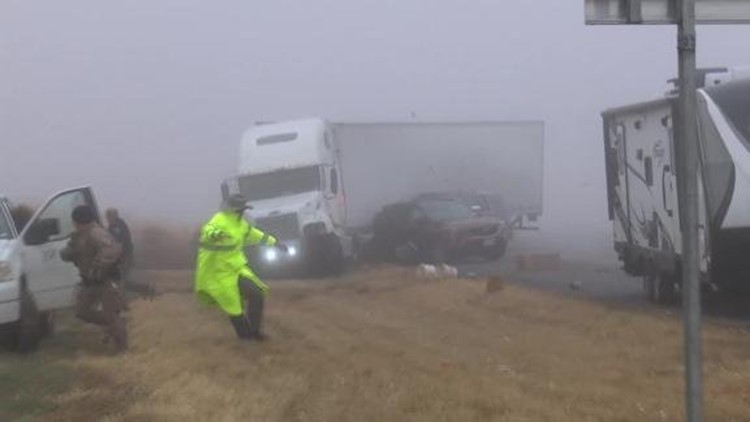
Source: tegna-media.com
This image serves as a stark reminder of the dangers involved in commercial vehicle accidents. It’s not just about the immediate impact; these incidents can have far-reaching consequences for all parties involved.
Identifying Liable Parties Beyond the Driver
In commercial vehicle accidents, it’s not just about the driver. The concept of vicarious liability means that trucking companies, cargo loaders, and even vehicle manufacturers could be held responsible. This broadens the scope of the case and potentially increases the compensation available to victims.
Vicarious liability is based on the legal doctrine of “respondeat superior,” which means “let the master answer.” In simpler terms, it means that employers can be held responsible for the actions of their employees while they’re on the job.
To establish vicarious liability, you must prove the driver was acting within the scope of their employment. This isn’t always as straightforward as it sounds. I once worked on a case where the trucking company tried to argue that the driver had deviated from his route for personal reasons at the time of the accident. It took some clever detective work and analysis of GPS data to prove that the driver was, in fact, still operating within his job duties.
But it doesn’t stop there. Third-party liability can extend to maintenance companies, parts manufacturers, and even government entities responsible for road conditions. I remember a case where we discovered that a faulty brake part contributed to the accident. We were able to bring the manufacturer into the lawsuit, significantly increasing the potential compensation for our client.
Here’s a quick rundown of potentially liable parties in commercial vehicle accidents:
| Potentially Liable Parties in Commercial Vehicle Accidents |
|---|
| Driver |
| Trucking Company |
| Vehicle Manufacturer |
| Cargo Loader |
| Maintenance Company |
| Government Entity (road conditions) |
In a recent truck accident case, a trucking company was held liable for an accident caused by their driver who had a history of safety violations. The company’s negligent hiring and supervision practices were key factors in establishing their liability. This case underscores the importance of thorough background checks and ongoing monitoring of driver performance.
If you’re interested in learning more about determining liability in accident cases, check out our guide on navigating brain injury settlements. While it focuses on a different type of injury, many of the principles for establishing liability are similar.
The Role of Electronic Logging Devices (ELDs)
Electronic Logging Devices (ELDs) have revolutionized commercial vehicle accident cases. These nifty little gadgets record a driver’s hours of service, providing crucial data that can make or break a case. Knowing how to obtain and interpret this information is essential for building a strong argument.
The Federal Motor Carrier Safety Administration (FMCSA) mandates ELDs for most commercial vehicles. It’s a game-changer in terms of accountability and safety. Gone are the days of easily falsified paper logs. Now, we have digital breadcrumbs that can tell us exactly what a driver was doing in the hours leading up to an accident.
I’ve seen cases where ELD data proved hours of service violations or falsification of records. It’s like catching someone with their hand in the cookie jar. But here’s the kicker – you need to act fast. Some ELD systems overwrite data after a certain period. I learned this the hard way early in my career when I waited too long to request the data in a case. Now, it’s one of the first things I go after.
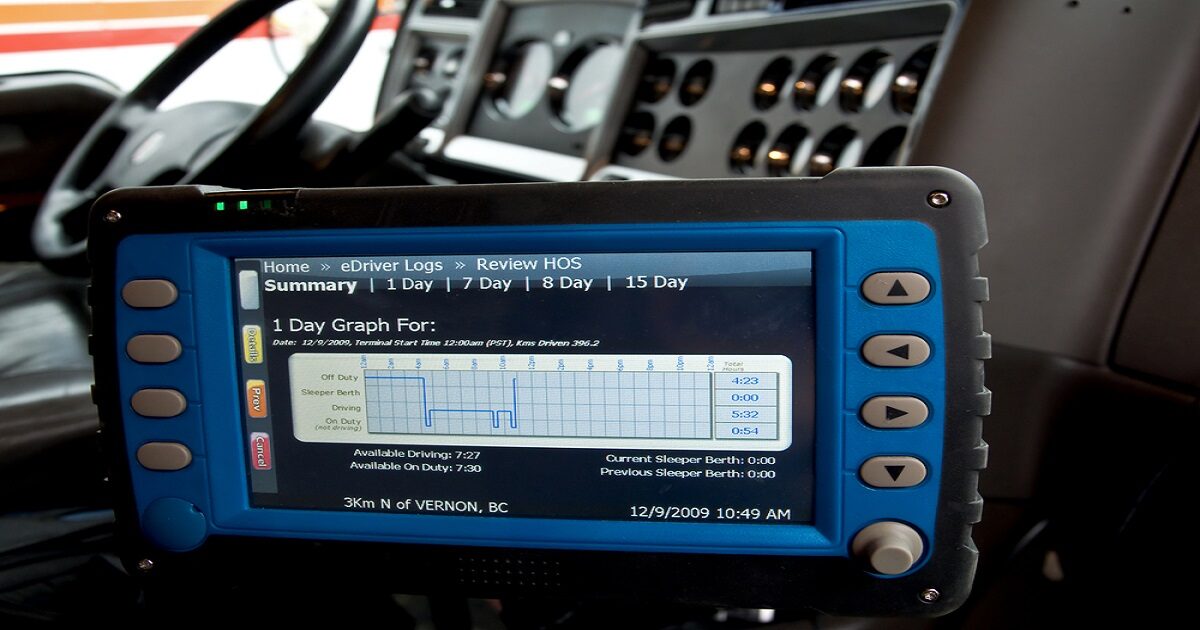
Source: lawyernc.com
This image shows a typical ELD interface. It might look simple, but the data it provides can be incredibly powerful in building a case.
Investigating Maintenance Records
Proper vehicle maintenance isn’t just good practice—it’s a legal requirement for commercial fleets. Scrutinizing maintenance logs can uncover negligence in upkeep practices, potentially strengthening your case.
The FMCSA requires motor carriers to maintain systematic inspection, repair, and maintenance records. It’s not just about ticking boxes; these records can reveal a pattern of neglect or cost-cutting measures that compromise safety.
I once worked on a case where a trucking company’s maintenance records showed a pattern of skipping brake inspections to save time and money. When we brought in an expert to analyze these records, it became clear that this negligence directly contributed to the accident. It was a crucial piece of evidence that significantly impacted the trucking accident settlements.
Maintenance violations can include issues with brakes, tires, lighting, and cargo securement. I’ve seen cases where something as simple as a burned-out taillight led to a catastrophic accident. It’s a stark reminder of how important every detail is in commercial vehicle operation.
Here’s a checklist of key maintenance records to review in trucking accident settlements:
□ Daily vehicle inspection reports
□ Scheduled maintenance logs
□ Repair invoices and work orders
□ Tire replacement and rotation records
□ Brake system inspection reports
□ Engine diagnostic reports
□ Cargo securement equipment checks
□ Driver reported mechanical issues
□ Compliance with manufacturer recall notices
□ Qualifications of maintenance personnel
This checklist has been a lifesaver in many of my cases. It ensures we leave no stone unturned when investigating maintenance-related issues.
Navigating Federal Motor Carrier Safety Regulations (FMCSRs)
Federal Motor Carrier Safety Regulations (FMCSRs) are the rulebook for commercial vehicle operations. These regulations impact liability in accident cases. Demonstrating violations of these rules can significantly strengthen a plaintiff’s position.
FMCSRs cover areas such as driver qualifications, vehicle maintenance, and hours of service. When I first started dealing with these regulations, I felt like I was learning a new language. But trust me, it’s worth the effort to understand them inside and out.
In some jurisdictions, violations of FMCSRs can be used to establish negligence per se. This legal doctrine means that if a defendant violates a statute designed to protect the public, they’re automatically considered negligent. It’s a powerful tool in the right circumstances.
One of the trickiest aspects of these cases is understanding the interplay between federal regulations and state traffic laws. I’ve seen defense attorneys try to argue that compliance with state law trumps federal regulations. Don’t fall for it. In most cases, commercial vehicles must comply with both sets of rules.
Here’s a sobering statistic: In 2021, one percent of truck collisions resulted in death and 22 percent resulted in injuries, according to the Federal Motor Carrier Safety Administration. It’s a stark reminder of why these regulations are so crucial.
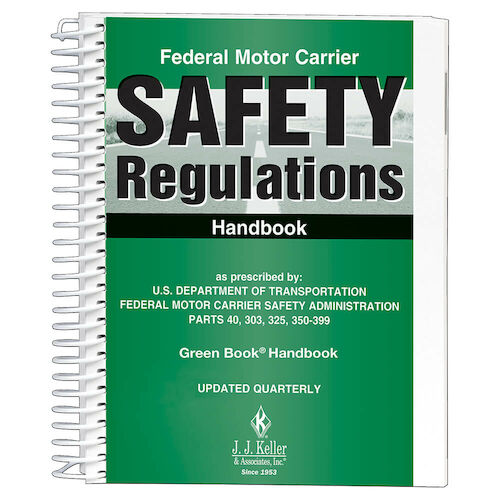
Source: jjkeller.com
This handbook is like the Bible for commercial vehicle regulations. I keep a copy on my desk at all times.
Hours of Service Violations
Hours of service rules are designed to prevent driver fatigue. Understanding these rules and proving violations can be a powerful tool in your legal arsenal and can significantly impact the average truck accident settlement.
Current HOS rules limit driving to 11 hours per day within a 14-hour window, followed by 10 consecutive hours off duty. It sounds straightforward, but trust me, it gets complicated fast. Drivers must also take a 30-minute break after 8 cumulative hours of driving.
Proving violations can be like putting together a puzzle. We often use a combination of ELD data, driver logs, and corroborating evidence like fuel receipts or toll records. I once worked on a case where we used cell phone tower pings to prove a driver was on the road when his logs claimed he was resting.
In a recent lawsuit, a plaintiff’s attorney used ELD data to prove that a truck driver had exceeded the legal driving hours by 3 hours on the day of the accident. It was a game-changer in establishing driver fatigue as a contributing factor.
If you want to understand how hours of service violations can impact liability, check out our guide on navigating Las Vegas car accidents. While it’s focused on car accidents, many of the principles about driver negligence apply to commercial vehicle cases as well.
The Art of Valuing Commercial Vehicle Accident Claims
Determining the value of a commercial vehicle accident claim is complex. It involves considering various factors that contribute to settlement amounts and verdict values. This process requires a deep understanding of both immediate and long-term impacts of the accident to arrive at an accurate average truck accident settlement.
Valuation often involves economic experts who can project future losses and expenses. I remember the first time I worked with a forensic economist. It was eye-opening to see how they could take a person’s age, education, and work history and project their lifetime earnings potential.
One method we sometimes use is the “multiplier method.” This involves multiplying the economic damages by a factor to account for non-economic damages like pain and suffering. The multiplier can vary widely depending on the severity of the injuries and other factors.
I recently came across an interesting development in the field. According to Newsfile Corp, “Lowenthal & Abrams, P.C. Expands Focus on Commercial Motor Vehicle Accident Victims, Rideshare Crash Victims in Harrisburg, PA”. It’s a sign of how this area of law is evolving and becoming more specialized.
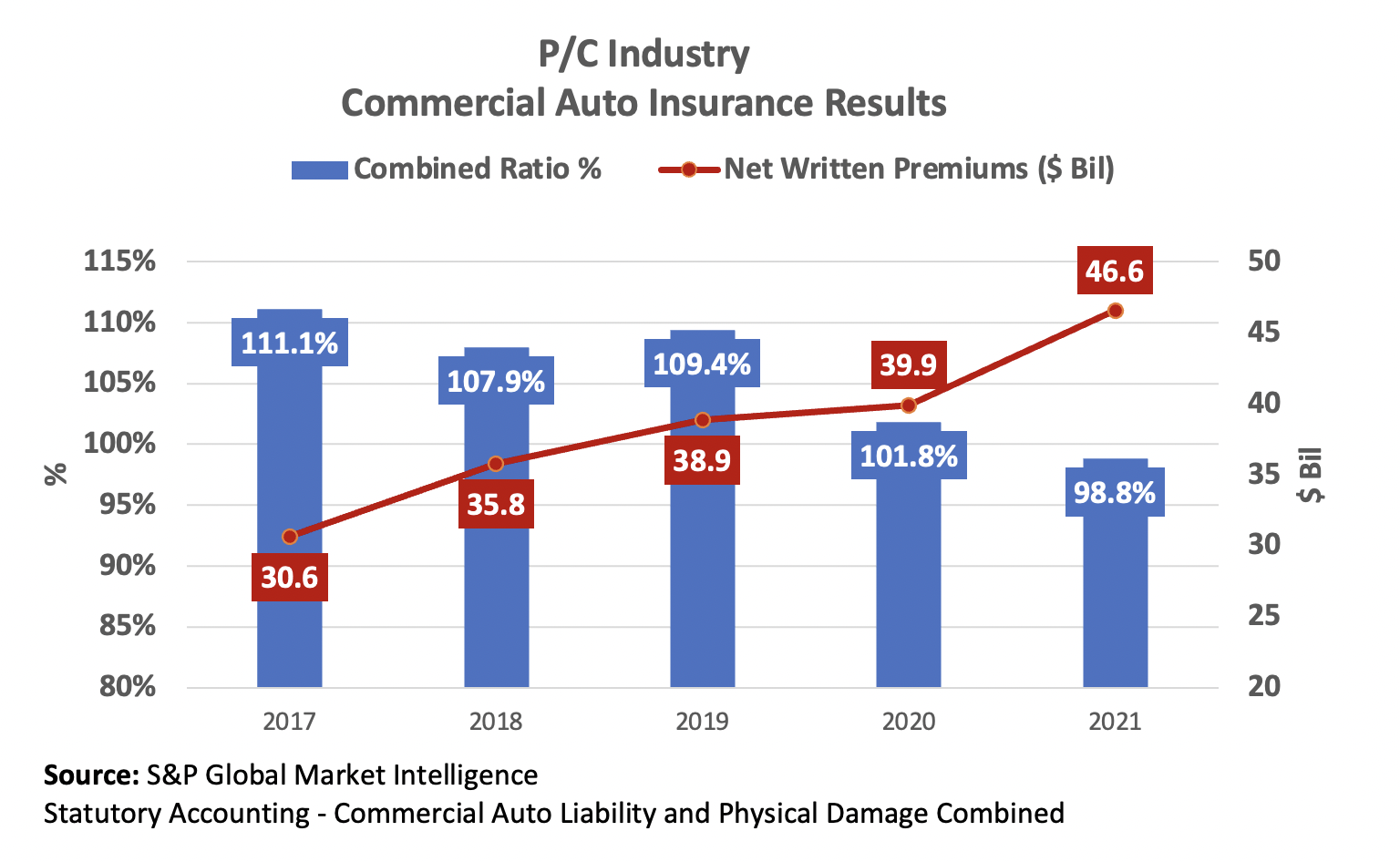
Source: carriermanagement.com
This chart shows the uncertainty in commercial auto recovery. It’s a reminder of why accurate valuation is so crucial in these cases.
Catastrophic Injuries and Long-Term Care Costs
Commercial vehicle accidents often result in severe, life-altering injuries. Calculating and projecting long-term medical expenses and life care costs is crucial for ensuring fair compensation for catastrophic injury cases and can significantly impact the commercial truck accident settlement.
Catastrophic injuries may include traumatic brain injuries, spinal cord injuries, or severe burns. I once worked on a case involving a young man who suffered a spinal cord injury in a truck accident. The process of projecting his lifetime care needs was incredibly complex, involving input from medical specialists, occupational therapists, and life care planners.
Long-term care costs can include medical treatment, rehabilitation, home modifications, and assistive technology. It’s not just about the immediate medical bills. We have to think about things like ongoing physical therapy, potential future surgeries, and even things like wheelchair-accessible vehicles.
The life expectancy of the injured party plays a significant role in projecting future costs. It’s a delicate balance – we want to ensure our clients are cared for throughout their lives, but we also need to be realistic and evidence-based in our projections.
[This video provides valuable insights into the long-term impacts of catastrophic injuries and the importance of comprehensive compensation in commercial vehicle accident cases.]
Video Source: YouTube
Life Care Planning Experts
Life care planning experts are invaluable in developing comprehensive future care projections. Their input can significantly impact settlement negotiations and trial outcomes by providing a detailed, evidence-based estimate of future needs.
These experts typically have backgrounds in nursing, occupational therapy, or vocational rehabilitation. I’ve worked with some incredible life care planners over the years. Their ability to break down a person’s needs into granular detail is truly impressive.
A life care plan includes detailed projections for medical care, therapy, medications, and adaptive equipment. It’s not just about the big stuff. I’ve seen plans that include things like the cost of replacing prosthetic limbs over a lifetime or the expense of modifying a home for wheelchair accessibility.
One thing to keep in mind – these plans are often challenged by defense experts. That’s why it’s crucial to work with life care planners who use thorough documentation and peer-reviewed methodologies. I once had a case where the defense tried to argue that our life care plan was overly generous. We were able to defend every line item with solid research and expert testimony.

Source: cdn-website.com
This image shows a life care planning expert at work. It’s a complex process that requires a deep understanding of medical needs and long-term care.
For more insights on how life care planning impacts settlements, check out our guide on maximizing slip and fall settlements. While it’s focused on a different type of case, many of the principles for projecting long-term care needs are similar.
Economic and Non-Economic Damages
Calculating damages in commercial vehicle accident cases requires a nuanced approach. You need to consider both tangible losses (economic damages) and intangible losses (non-economic damages) to ensure full compensation in commercial truck accident settlements.
Economic damages are the more straightforward part of the equation. They include medical expenses, lost wages, and property damage. These are typically easier to quantify because they have clear dollar amounts attached to them.
Non-economic damages, on the other hand, cover pain and suffering, emotional distress, and loss of enjoyment of life. These are trickier to quantify but no less important. I once had a client who was a professional musician before his accident. His physical injuries healed, but he lost the ability to play his instrument at a professional level. Quantifying that loss was challenging but crucial for ensuring he received fair compensation.
It’s important to note that some jurisdictions place caps on non-economic damages. This can impact overall case valuation. I always make sure to research the specific laws in the jurisdiction where we’re filing the case.
Here’s a breakdown of the types of damages we typically see in commercial vehicle accident cases:
– Loss of enjoyment of life
| Types of Damages in Commercial Vehicle Accident Cases |
|---|
| Economic Damages |
| – Medical expenses |
| – Lost wages |
| – Property damage |
| – Future medical costs |
| Non-Economic Damages |
| – Pain and suffering |
| – Emotional distress |
| – Loss of consortium |
Hedonic Damages
Hedonic damages, or loss of enjoyment of life, is a concept that’s gaining traction in commercial vehicle accident cases. Understanding how to quantify and present these damages can significantly impact your case’s value.
The theory behind hedonic damages is that life has intrinsic value beyond economic productivity. It’s about the joy, satisfaction, and fulfillment we derive from our daily activities and relationships. Quantifying these losses often involves expert testimony from economists or life care planners.
I recall a case where our client, an avid hiker and outdoor enthusiast, was left paralyzed after a truck accident. We brought in an expert to testify about the value of the activities he could no longer enjoy. It was powerful testimony that resonated with the jury.
It’s worth noting that jurisdictions vary in how they treat hedonic damages. Some consider them part of pain and suffering, while others treat them as a separate category. Knowing the specific laws in your jurisdiction is crucial for effectively presenting these damages.
Punitive Damages in Egregious Cases
In cases involving gross negligence or willful misconduct, punitive damages may be pursued. These damages are designed to punish the wrongdoer and deter similar behavior in the future.
Pursuing punitive damages typically requires proof of reckless disregard for safety or intentional misconduct. I’ve seen cases where trucking companies knowingly allowed drivers with multiple safety violations to continue operating. That’s the kind of behavior that can justify punitive damages.
Many states have caps or limits on punitive damages. It’s essential to be aware of these limitations when considering whether to pursue punitive damages. In some cases, the threat of punitive damages can be a powerful negotiating tool, even if they’re unlikely to be awarded at trial.
Evidence of a company’s financial condition is often admissible when determining punitive damages. The idea is that the punishment should be significant enough to deter future misconduct, but not so large as to bankrupt the company.
In a landmark case I followed closely, a jury awarded $1 billion in punitive damages against a trucking company that had a history of falsifying driver logs and pushing drivers to exceed hours-of-service limits. While the award was later reduced on appeal, it sent a clear message about the seriousness of these violations.
Advanced Litigation Strategies for Maximum Compensation
Securing favorable outcomes in commercial vehicle accident lawsuits often requires innovative legal strategies. By employing cutting-edge approaches, you can tip the scales in your favor and maximize compensation in your truck accident case and semi truck accident settlements.
Advanced strategies often involve interdisciplinary approaches, combining legal expertise with technological and scientific advancements. I’ve found that staying current with developments in fields like accident reconstruction, biomechanics, and data analytics can give you a significant edge.
The admissibility of novel evidence or methodologies may require Daubert hearings or similar proceedings. These hearings can be make-or-break moments in a case. I’ve seen cases won and lost based on whether certain expert testimony was allowed.
It’s worth noting that the average jury verdict for large commercial trucking companies is approximately $510,000, with FedEx cases often yielding slightly higher verdicts. However, these figures are just averages. With the right strategy, it’s possible to secure much higher compensation in cases involving severe injuries or egregious misconduct.
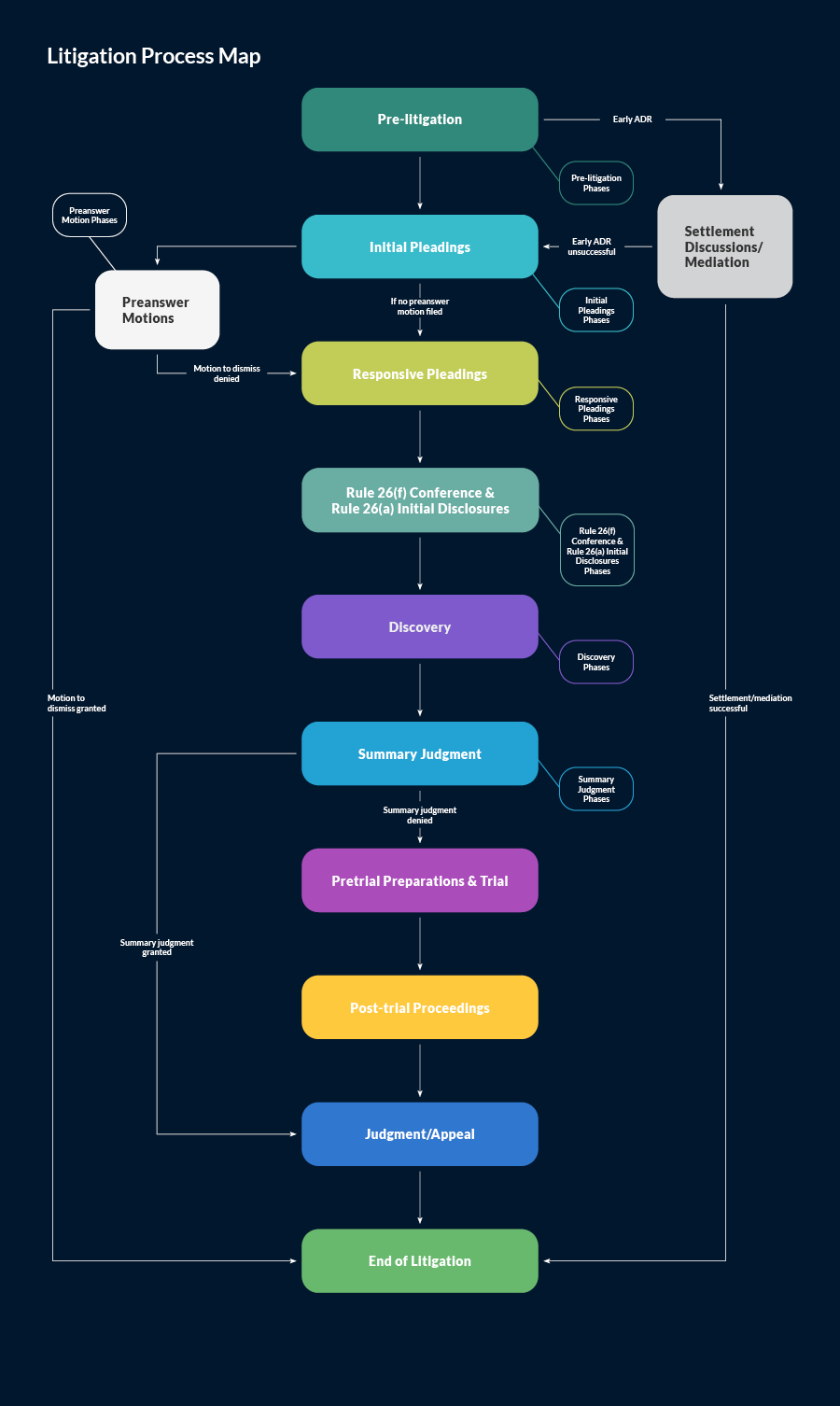
Source: lexisnexis.com
This process map gives a bird’s-eye view of civil litigation. It’s a complex journey, but understanding each step is crucial for developing effective strategies.
Leveraging Technology in Case Presentation
Modern technology can significantly enhance the persuasiveness of your case. Effective use of accident reconstruction software, virtual reality, and other technological tools can be game-changers in settlement negotiations and at trial.
3D accident reconstruction can provide jurors with a clear, immersive understanding of the incident. I remember the first time I used a 3D reconstruction in court. The jurors were captivated, and it made complex physics concepts much easier to understand.
Virtual reality simulations can demonstrate the long-term impact of injuries on daily life. I once used a VR simulation to show how a spinal cord injury affected a client’s ability to perform simple tasks. It was a powerful way to convey the reality of living with a disability.
Data visualization tools can help present complex financial or statistical information in an easily digestible format. In one case, we used interactive charts to show how a trucking company’s safety violations had increased over time. It was much more impactful than simply presenting numbers on a spreadsheet.
3D Printing for Physical Evidence
3D printing technology allows for the creation of tangible representations of accident scenes or vehicle defects. These physical models can greatly enhance jury comprehension and the overall strength of your case.
3D-printed models can be based on laser scans of actual vehicles or accident scenes. They provide a level of detail and accuracy that’s hard to achieve with traditional models or diagrams.
These models can demonstrate issues like blind spots, impact dynamics, or mechanical failures. I once used a 3D-printed model to show how a defective truck component contributed to an accident. Being able to hand the model to jurors and let them examine it up close was incredibly effective.
The admissibility of 3D-printed evidence may require establishing a clear chain of custody and expert authentication. It’s crucial to work with reputable experts and follow proper protocols to ensure your evidence will be allowed in court.
Strategic Use of Depositions
Depositions are powerful tools in commercial vehicle accident cases. Advanced deposition techniques tailored to key witnesses in the trucking industry can uncover crucial information and strengthen your position in a truck accident case.
Effective depositions often require extensive preparation and industry-specific knowledge. I spend hours researching a deponent’s background and role in the company before sitting down for a deposition. It’s not uncommon to uncover valuable information that wasn’t included in the initial discovery responses.
Deposition strategies may include the use of “reptile theory” techniques to highlight safety rule violations. This approach focuses on getting witnesses to acknowledge the existence of safety rules and then demonstrating how those rules were violated.
Video depositions can be particularly effective for preserving testimony for trial or settlement negotiations. I’ve had cases where a key witness was unavailable for trial, but their video deposition testimony was crucial in securing a favorable outcome.
30(b)(6) Depositions of Trucking Companies
Corporate representative depositions under Rule 30(b)(6) can be instrumental in uncovering systemic issues within trucking companies that may have contributed to the accident. These depositions require careful planning and execution to be truly effective.
30(b)(6) depositions allow you to question a company about specific topics, requiring them to designate knowledgeable representatives. It’s a powerful tool for getting information about company policies and practices.
Topics can include safety policies, training programs, and compliance with federal regulations. I’ve had cases where 30(b)(6) depositions revealed that a company’s safety program existed only on paper and wasn’t actually implemented in practice.
Preparation for these depositions often involves extensive document review and consultation with industry experts. It’s not uncommon to spend days preparing for a single 30(b)(6) deposition. The payoff can be substantial, though, as these depositions often yield critical information for your case.
For insights on effective deposition strategies, check out our guide on Las Vegas truck accidents. While it’s focused on a specific location, many of the deposition techniques discussed are applicable to commercial vehicle cases nationwide.
Negotiating and Structuring Settlements
The settlement process in commercial vehicle accident cases can be intricate, often involving multiple insurers and large sums. Developing strategies for negotiating optimal truck accident settlements and structuring semi truck accident settlement payouts is crucial for ensuring the best outcome for your client.
Settlement negotiations in commercial vehicle cases often involve layers of insurance coverage, including primary and excess policies. Understanding the interplay between these policies is crucial. I’ve had cases where tapping into excess coverage made the difference between a good settlement and a great one.
Understanding the tax implications of different settlement structures is crucial for maximizing the client’s net recovery. It’s not just about the gross settlement amount; it’s about how much the client actually takes home after taxes and fees.

Source: researchgate.net
This flow chart illustrates the complexity of the negotiation and settlement process. It’s a dance that requires skill, patience, and strategic thinking.
Mediation Tactics for High-Stakes Cases
Mediation can be a crucial step in resolving commercial vehicle accident claims. Advanced mediation strategies tailored to the unique aspects of these cases can lead to more favorable outcomes without the need for a trial.
Effective mediation often involves careful selection of a mediator with experience in commercial vehicle cases. I look for mediators who understand the complexities of trucking regulations and insurance coverage issues.
Pre-mediation exchanges of key evidence or expert reports can set the stage for productive negotiations. I’ve found that sharing a compelling video settlement brochure before mediation can be particularly effective in setting expectations and framing the discussion.
Understanding the decision-makers on the defense side, including insurance adjusters and corporate representatives, is crucial for successful mediation. Knowing who has the authority to make settlement decisions and what factors influence those decisions can help you tailor your approach.
Pre-Mediation Demands
Crafting effective pre-mediation demands sets the stage for productive negotiations and favorable outcomes. These demands should be comprehensive, well-supported, and strategically timed.
Pre-mediation demands should include a detailed breakdown of damages, supported by expert reports and evidence. I typically include a life care plan, economic loss analysis, and detailed medical records to substantiate our demand.
The timing of the demand can be crucial, allowing the defense time to evaluate and obtain settlement authority. I’ve found that sending the demand about a month before mediation gives the defense team enough time to review and respond, but not so much time that they can drag their feet.
Consider including non-monetary terms in the demand, such as policy changes or safety improvements. These can be particularly effective in cases involving systemic safety issues. I once negotiated a settlement that included a requirement for a trucking company to implement additional driver training programs.
Structured Settlements vs. Lump Sum Payments
Choosing between structured settlements and lump sum payments can have long-term implications for your client in a semi truck accident settlement. Understanding the pros and cons of different settlement structures is essential for determining the most beneficial arrangement for your client’s long-term interests.
Structured settlements can provide tax advantages and guaranteed income over time. They’re particularly beneficial for clients who might struggle with managing a large lump sum or who have long-term medical needs.
Lump sum payments offer flexibility but may require careful financial planning. They can be appropriate for clients who have immediate large expenses or who are confident in their ability to manage and invest the funds.
The choice between structures often depends on the client’s age, financial situation, and long-term needs. I always involve a financial advisor in these discussions to ensure my clients understand the implications of their choices.
Qualified Settlement Funds
Qualified Settlement Funds (QSFs) can be valuable tools in complex cases involving multiple claimants or when seeking tax benefits for the injured party. Understanding how to effectively use QSFs can provide significant advantages in settlement negotiations and post-settlement planning.
QSFs allow for the separation of the settlement from the allocation process, providing time for careful planning. This can be particularly useful in cases with multiple plaintiffs or complex tax implications.
These funds can offer tax deferral benefits and flexibility in structuring payments. They give clients time to make informed decisions about how to receive their settlement funds without feeling rushed.
Setting up a QSF requires compliance with specific IRS regulations and court approval. It’s not a simple process, but the benefits can be substantial in the right cases.
Here’s a template of factors to consider when evaluating settlement structures:
1. Client’s age and life expectancy
2. Immediate financial needs vs. long-term security
3. Anticipated future medical expenses
4. Potential for future complications or additional treatments
5. Client’s ability to manage a lump sum
6. Tax implications of different settlement structures
7. Inflation and cost of living adjustments
8. Flexibility for unforeseen circumstances
9. Protection from creditors or potential lawsuits
10. Impact on government benefits eligibility
This template can help guide discussions about settlement structures and ensure all relevant factors are considered when determining the most appropriate approach for your client’s average truck accident settlement.
Ultra Law: Your Ally in Commercial Vehicle Accident Cases
At Ultra Law, we understand the complexities of commercial vehicle accident lawsuits. Our team of experienced attorneys is dedicated to fighting tirelessly for your rights and securing the maximum compensation you deserve. We have a proven track record of achieving favorable average truck accident settlement amounts and commercial vehicle accident settlement outcomes.
We offer personalized representation and work on a contingency fee basis, meaning you don’t pay unless we win your case. Our approach combines deep legal knowledge with cutting-edge technology and a network of expert witnesses to build the strongest possible case for our clients.
If you’ve been involved in a commercial vehicle accident, don’t navigate this complex legal terrain alone. Contact Ultra Law today for a free consultation and let us put our expertise to work for you. We’ll help you understand what to expect for your average truck accident settlement and guide you through every step of the process.
Key Learnings Recap
• Commercial vehicle accident lawsuits involve multiple parties and complex regulations
• Identifying all liable parties is crucial for maximizing compensation
• Understanding and leveraging FMCSRs can strengthen your case
• Accurate valuation of claims requires consideration of long-term impacts and expert input
• Advanced litigation strategies, including technology use, can significantly impact case outcomes
• Effective negotiation and settlement structuring are essential for optimal results
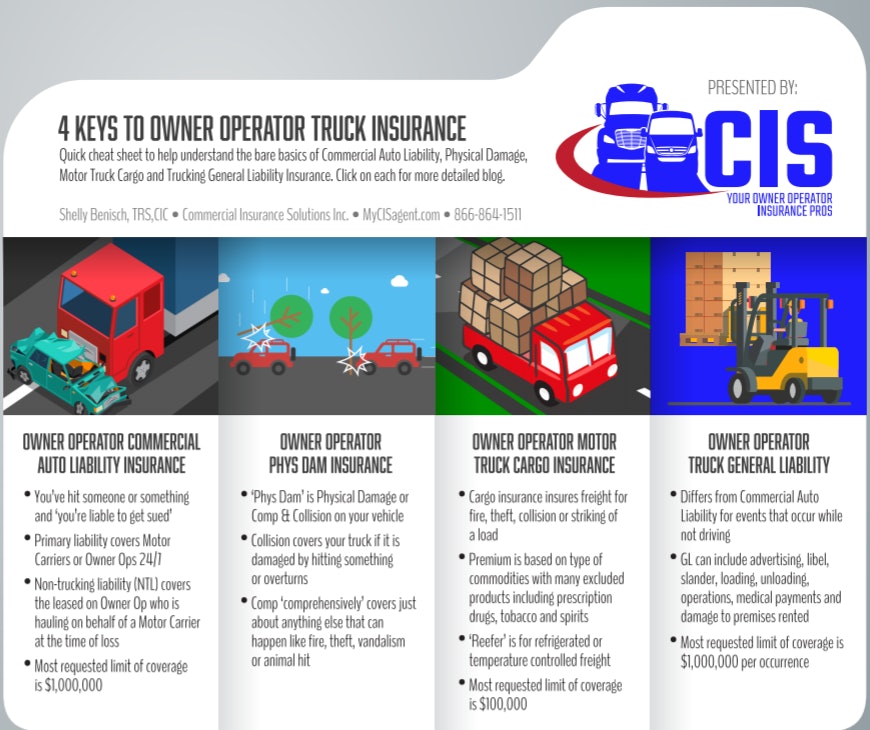
Source: overdriveonline.com
By mastering these critical aspects of commercial vehicle accident litigation, attorneys can provide superior representation for their clients and achieve more favorable outcomes. The landscape of these cases continues to evolve, with technological advancements and changing regulations shaping the field. Staying informed and adaptable is key to success in this challenging area of law.
Remember, each case is unique and requires a tailored approach. The strategies and insights provided in this guide serve as a foundation, but successful litigation often demands creativity, persistence, and a deep understanding of both the law and the trucking industry.
As you move forward in your practice, continue to build your network of experts, stay abreast of regulatory changes, and refine your litigation techniques. With dedication and expertise, you can navigate the complexities of commercial vehicle accident lawsuits and make a significant difference in the lives of those affected by these devastating incidents.
Here’s a checklist of key factors influencing truck accident settlement amounts:
□ Severity of injuries and long-term prognosis
□ Extent of property damage
□ Clear evidence of liability
□ Strength of expert testimony
□ Quality of accident reconstruction
□ Documented violations of FMCSRs
□ Extent of insurance coverage available
□ Victim’s age and earning capacity
□ Jurisdiction and local legal precedents
□ Effectiveness of legal representation
This checklist can help you assess the potential value of a case and understand how much are most truck accident settlements in similar circumstances.
In conclusion, mastering commercial vehicle accident lawsuits requires a multifaceted approach. From understanding the unique landscape of these cases to employing advanced litigation strategies and negotiating optimal settlements, every step of the process demands careful consideration and expertise. By staying informed, leveraging technology, and maintaining a client-focused approach, you can navigate these complex cases successfully and achieve the best possible outcomes for those affected by commercial vehicle accidents.




